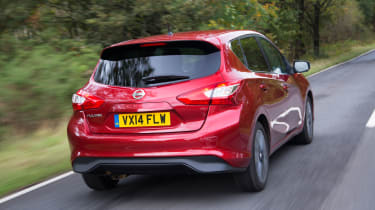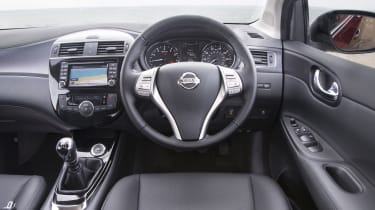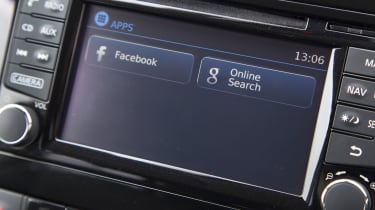Nissan Pulsar 2014-2018 review - Interior, design and technology
Unadventurous, occasionally awkward styling hides lots of impressive tech, but interior fit and finish doesn’t quite cut it
Nissan’s clearly played it safe with the Pulsar’s looks, copying the ‘V-shaped grille’ and contoured bonnet from the Qashqai, although there are LED headlights available to give some visual interest.
Despite the ‘boomerang’ tail-lights, roof spoiler and contoured surfacing down the car’s flanks, the Pulsar appears boxy and rather awkward from some angles. Part of this is due to the 1.2 petrol and 1.5 diesel Pulsar only being available with 16-inch or 17-inch wheels – the larger 18-inch alloys on the 1.6-litre DIG-T 190 certainly help to balance the looks. On the other hand, big wheels jeopardise the commendable ride quality, so it’s a sensible compromise on Nissan’s behalf.
Lessons learned from the Qashqai have been incorporated inside, albeit with patchy results. The ‘floating’ centre stack is distinctive, and the steering wheel is taken straight from the Qashqai, but the wood grain-effect finish on the dash panel looks a bit tacky, and the interior light switch located above you looks straight out of the eighties.
The plastics aren’t up to the standard of those found in the Ford Focus or SEAT Leon, although the thoughtfully laid-out switchgear works with slick precision. The cabin is solidly screwed together, too, and well up to the rough and tumble of family life.
There’s plenty of standard kit, including Bluetooth and a USB connection. You also benefit from climate and cruise control, plus keyless entry. Further highlights include the Qashqai-style colour TFT display located between the speedo and rev counter, and gloss-black centre console finish.
Sat-nav, stereo and infotainment
You have to choose the n-tec or Tekna specification if you want sat-nav on a Pulsar, but you shouldn’t be disappointed by the NissanConnect infotainment system, which has smartphone integration built-in.
It works with iPhone, Android and Blackberry operating systems (although it's not Apple CarPlay or Android Auto compatible) and allows you to run various smartphone apps through the central touchscreen display on the dash. So if you’re a social media addict you can keep up to date on the move – or access more practical applications like Google or TripAdvisor.
Supplementing the central touchscreen is a five-inch TFT display between the dashboard dials that shows turn-by-turn info in sat-nav equipped cars, as well as other useful stuff like audio track details and Safety Shield status.
The standard audio system has a CD player and four speakers, but upgrading to Acenta spec or above gives you a six speakers.






